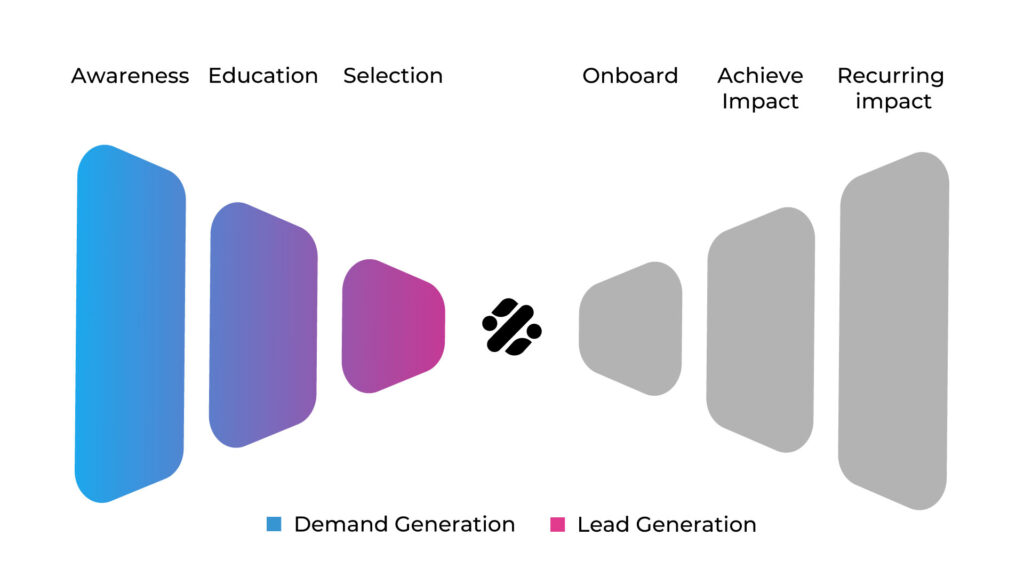Struggling with B2B demand generation? You’re not alone. It’s a common challenge for businesses – it can be expensive, measuring results is tricky, and doing it well requires significant effort.
But here’s the truth: effective demand generation is essential for scaling any B2B business. If your target audience doesn’t know you exist, they can’t possibly become your customers.
Where to begin with demand generation
When looking at the bowtie funnel, we see that demand gen sits on the left side just before demand capture. One rule of thumb when thinking about the bowtie model is that the accuracy of measurement increases from left to right. The same thing goes for the returns you get from your efforts.

And it makes sense. With demand gen, you are trying to educate people and make them aware of your product or business. With demand capture (lead generation), you are trying to convert them into paying customers. And with the efforts on the right side of the bowtie, you are trying to cross-sell, up-sell and maybe get referrals from the existing users.
So in order to have successful demand generation campaigns you need to get some things in order.
Set clear expectations
You will need to ask yourself what exactly you want to get out of your demand gen campaigns. If you want to get customers at a low cost per acquisition (CPA), don’t even think about it. This is not the point of demand generation.
You will need to be prepared to adventure into uncertainty and creative ways of looking at your numbers. But also looking at the bigger picture to find explanations for the results you get.
Have a clear budget in mind
The budget you allocate to demand gen is totally up to you and your business. You can go for a fixed amount per month or a percentage of the total business revenue. It doesn’t matter.
You will just have to be prepared to spend it and see no direct and immediate results from it. This doesn’t mean you will just spend your budget for the sake of spending it. You will still have results but you will need to look at proxy metrics.
For example, if you want to see how demand gen is affecting your traffic, you can compare the traffic levels of the other channels. Do they shift according to your demand gen efforts? Do you see an uplift in traffic for the other channels?
If you want to check the monetary gains, it’s the same thing. But you will have to look at the revenue. And for this, you can use the marketing efficiency ratio as a performance metric.
Study and target your Ideal Customer Profile (ICP)
Identify who your best customers are and where they are spending their time online and offline. Study what drives them, where they get their information, what type of information they are consuming, and in which format.
The more you know, the better you can target them in the way they are most likely to receive your message. You can’t just put content out and hope that they will find it. You have to craft helpful content that will make their lives easier and then publish it where they will most likely be browsing.
The best way of getting all this information is to talk with your existing customers. Ask them how they found out about your business and which materials they found most helpful.
Segment your audiences
In your research, you will most likely find out that you have more than one customer avatar. So you should also adapt your message to fit them. Even in demand gen you can have nuances: you can target warmer or colder traffic.
For example, there are people who have no idea of the solution to their problem. And there are people who know there is a solution but don’t know all the benefits, so they don’t pursue the idea. And they should be targeted with separate messages.
Also, think about the influence the person has in the company. Distinguish between conversation starters and decision makers and use different channels and different messaging to target them.
Regardless of what you choose to do with your audience segmentation, just don’t use the same message and channel to target everyone. Remember: if you’re going for everyone, you’re getting no one.
Build trust
How many times have you seen a random ad for the first time and signed up for a $3000 service?
If you have ever bought a high-ticket product or service, think of the steps you took. How many hours did you spend on researching the product/service or the company selling it? Why would you think your target audience would do things differently?
So, with your demand gen efforts, you should focus on building the relationship with your customers. You have to prove yourself first. You will have to focus on providing as much free information and value as possible.
This will help you position your business as a go-to place for information and knowledge in the industry. The more knowledge you share with your audiences the more authority you build. And that trust will transfer to your products and services increasing their perceived quality.
Essential tactics for demand generation

Now that we have discussed some of the main points of demand generation, let’s also see what exactly you can do.
SEO efforts
When thinking about demand generation SEO content, you should not be thinking about going for the keywords describing your business positioning or the product/service category. Those are steering more toward demand capture.
With the demand gen blog articles or content your aim should be to discuss various problems your audience encounters in their business.
For example, if you have a law firm handling divorces, you can write articles about golf. It may sound weird, but the logic is there. Golf is an expensive sport, so you are already targeting high-income individuals with your content. These individuals are more prone to actions that might lead to a divorce.
Social traffic
Getting ranked on search engines is a tough business. And sometimes, you might just need to look out for new ideas and traffic sources.
So you can leverage your social media presence to push your content and experiment with different types of formats. For example, if your blog articles are not ranking well yet, you can try social ads to get them to your audience.
Or you create a YouTube channel to talk about the same stuff you are writing about. Ranking on YouTube is much easier than ranking on Google, for example. There is just less competition. Also, you can boost your message with video ads to make sure you reach your audience.
Account-based marketing
If you have a list of potential customers that would be great to add to your portfolio, you can directly target them with account-based marketing (ABM) campaigns.
The campaigns focus on going after and building relationships with strategic accounts. And by doing this, you can shorten the sales cycle for them.
ABM campaigns can take many forms from email, tailored content, paid ads, or landing page personalization.
Podcasts and webinars
If you have done your research properly, you will know exactly what struggles your audience has. So why not focus on helping them out with the information they need by hosting a webinar or a podcast?
And I’m not talking about a sales webinar where you present a problem after which you plug your product or service as the solution. Remember, we want to provide value and build trust and authority.
So instead you can organize a series of webinars and interviews with specialists from different domains. And just discuss any specific issues your customers are encountering.
Leverage user-generated content
User-generated content is proven to be effective when building trust. According to Nielsen, it is 20% more influential when it comes to purchase decisions and 35% more memorable than other types of media.
In B2B things might sound a little bit harder than in the B2C space. But the secret is to create an attractive space and people will join it. It sounds a little bit cryptic but think about building an online community/forum, creating user-generated FAQs, or creating video testimonials with your clients.



